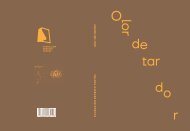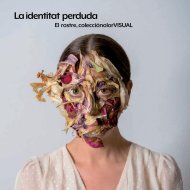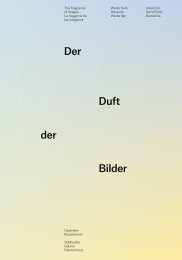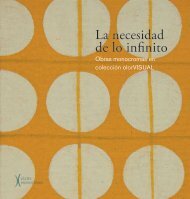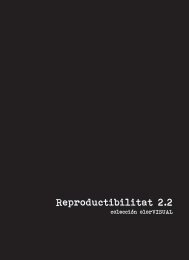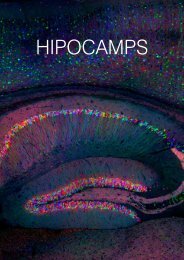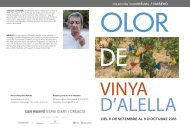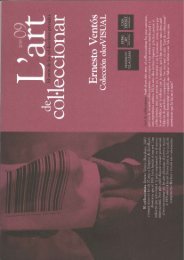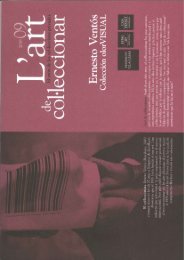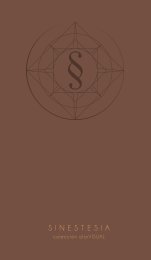24Electric
Create successful ePaper yourself
Turn your PDF publications into a flip-book with our unique Google optimized e-Paper software.
changes profoundly and becomes a rich, sumptuous<br />
apparel. A companionable smell. The light in a photograph,<br />
as in a mirror, brightens some areas at the<br />
cost of darkening others. The place of the spectator is<br />
disturbing because it is uncertain.<br />
12<br />
Douglas Gordon<br />
On the matter of privileged or provoked senses:<br />
the work of douglas gordon<br />
Some modern artists understood that the new creative<br />
processes, the so-called visual arts, could<br />
embrace not just aspects of representation or reproduction<br />
but aggressive and transgressive attitudes<br />
that instead of conserving the established dispensation<br />
led to its destruction, a radically new possible<br />
form of the ambient reality. Everything we see is real,<br />
but everything that we convert as such, to which we<br />
give new presence, is also real. This artistic option<br />
makes sense in as much as it offers real active presences<br />
that oblige us to give them content, meaning,<br />
even though it be unusual, unexpected, on occasion<br />
obliged by the new coherence that must be ordered<br />
from the senses so that what is presented is accessible<br />
to the intellect. Douglas Gordon is one of those<br />
assaulters of the immediate and of practice who<br />
makes use of time but also — as in the present case<br />
— of fire. A time or a fire that are controlled, handcuffed,<br />
that suspend their action and activity when<br />
the artist so decides, which is when he has seen to it<br />
that the observer follows him and not the original object<br />
that motivated the action.<br />
These images thus suspended and interrupted in<br />
time in his other processes, including the aggressive,<br />
lend themselves, offer themselves to new functions.<br />
The one in the olorVisual collection goes from being<br />
an attacked photograph, for some subjective reason<br />
or aberrant sadistic game, regardless of the disfigurement<br />
achieved, to take on a new sense and meaning:<br />
the nose has been altered and at this precise moment<br />
what the image cries out for and makes manifest is<br />
the imperative of smell. We are then led to wonder<br />
— with or without the consent of the aggressor —<br />
what basic sense he wanted to dispossess the image<br />
of. That of beauty or that of smell? He has achieved<br />
both and the second to excess, making manifest the<br />
horrific and, for the arsonist, sweet smell of the fire<br />
that burns or the stinking reek of burnt meat.<br />
A worthy Turner Prize, Douglas Gordon.<br />
13<br />
Cecilia de Val<br />
Arnau Puig<br />
Recollections are imprinted on that kind of parchment<br />
we call memory. The quickest and surest way<br />
to probe it is by way of smells; Proust knew that, and<br />
how to tell it in words. I realized it and wanted to express<br />
it by means of an image by photographing the<br />
place which, in the form of an old storeroom filled<br />
with papers, represented my childhood. The papers<br />
still retained the old smell of the tree from which they<br />
were born, as well as that of amber and all the years<br />
that imprinted their weight of dust, the smell of the<br />
ink that gave them life, my tiny fingers discovering<br />
the other realm that lives in the pages of what they<br />
tell me is called book, the smell of the cedar that<br />
was a pencil that marked the flat white paper which<br />
could be, if it passed through my father’s hands, an<br />
elephant or a giraffe. The smell of my memory is as<br />
multifaceted and complex as that of paper.<br />
14<br />
Jamie Baldridge<br />
It is said that the sense of smell is most closely tied<br />
to memory and for me this is most certainly the case.<br />
A whiff of cheap, but respectable, department store<br />
perfume can transport me back thirty years to the<br />
comfort of my grandmother’s parlor, while the more<br />
bohemian notes of patchouli and sandalwood will<br />
instantly bring to mind the summer I first fell in love<br />
and the small, moonlit breasts of my lover as she snored<br />
softly beside me. I truly believe that smells can<br />
transport us, not just in memory, but to places that<br />
are uniquely divine.<br />
My studio is a sacred place and I fill the air with<br />
sacramental smoke while I work. In the corner of the<br />
room, beneath my collection of odds and ends from<br />
my travels, a censer oozes heavy tendrils of Frankincense<br />
and Oud smoke, some of which reach slowly<br />
heavenward, some of which puddle lazily on the tabletop<br />
and mix seductively with the notes of tobacco<br />
and hashish coating my fingertips. As the air in my<br />
studio becomes a perfectly soft homogenous haze of<br />
incense, I can transport my mind more easily into my<br />
work and imagine a new reality. My religion is in this<br />
place, without physical dimension, but tied inexorably<br />
to the tears of boswellia and the divine infection<br />
of agarwood. If a person were of a mind to occupy<br />
themselves with my work more perfectly, I would<br />
have them inhale these same earthly smells while<br />
they considered my creations.<br />
In the Morning, Trotsky smells to me of warm buttermilk,<br />
lavender soap, and well trodden, well-aged<br />
cedar floor boards.<br />
15<br />
Richard Billingham<br />
My father out cold on the toilet floor at home. Oblivious<br />
to stench and squalor.<br />
16<br />
Esther Ferrer<br />
It’s with collard greens.<br />
17<br />
Roger Ballen<br />
My sense of smell knows when nature is close.<br />
18<br />
John Coplans<br />
Coplans revisited<br />
Coplans’ self-portrait photographs of his body evoke<br />
multiple readings. In the large close-up of his hand,<br />
which is precisely the one I have in front of me now,<br />
I see a carnal flower whose spring is now a matter of<br />
long memory: a Proustian madeleine. People put on<br />
perfume to be remembered. John Coplans photographed<br />
himself for the same reason. His perfume<br />
is called Art, and tends to be more lasting than the<br />
most penetrating of fragrances.<br />
When I contemplate the lines of this hand, I think<br />
of the years lived and of fresh flowers that are at the<br />
same time dried out by time and its circumstances.<br />
None of the five senses revives the memory like smell<br />
does. Seneca thought that anyone who frequented<br />
the perfumery, even if only for a short time, would<br />
carry with them the perfume of the place. And that<br />
is what is borne by that hand which also, though very<br />
much his own, belongs, thanks to art, to me and to<br />
all of us. A fragile flower, as brief and persistent as<br />
the smell of violets; a smell that is the silence of a key<br />
unlocking the door of memory. A smell that awakens<br />
and provokes more than any sound. When I look at<br />
and study that hand, I think how right that close-up<br />
is that imposes itself on our retinas by virtue of its extra-corporeal<br />
dimension. This is the first time that we<br />
have seen from so close flesh so much the same and<br />
so other than our own. In such conditions of proximity<br />
we would inevitably smell the salts in the sweat,<br />
musk, amber, muted testosterone, perhaps even<br />
garlic, wine, amber and tobacco. But we smell nothing<br />
of the kind in the inescapable image of a part of<br />
our body that we never notice, since it has never risen<br />
above its utilitarian level. That hand is converted into<br />
art when its oldness and its fragility are exposed to<br />
our absent-minded eye with detailed excess, while<br />
we, in contrast, only give our hands to others as an<br />
unavoidable part of social convention. Coplans’ hand<br />
invites us to look at the nails, the hairs of the fingers,<br />
like a forest razed by a pyromaniac. The creases of<br />
the palm, from which a chiromancer could give us<br />
a reading of the artist’s life, are hidden by the middle<br />
and ring fingers. The oldness and newness of the<br />
image compete on our retinas for a privileged space<br />
in our consciousness, and out of this conclusion are<br />
born the memory and the smell that is the smell of<br />
the present. The smell somewhere between the old<br />
and the new, the lived and the intuited. The smell of<br />
memory and of art, with roots as deep as the lines of<br />
this old hand resisting with all its wisdom the final<br />
winter, is the smell given off by that language of signs<br />
that are as hermetic as they are childish. An invitation<br />
to play, a bittersweet code that, in a language that<br />
is quiet without being mute, speaks to us of Expressionism,<br />
Existentialism, Surrealism, photography,<br />
perception, language, theatre, and a great knowledge<br />
of art and its theories, along with the impossibility<br />
of enjoying an eternal spring. The last time I<br />
saw my friend Coplans, a couple of years ago now,<br />
he still used as a tag to every phrase the words ‘as<br />
you can see’, ‘as you can see’. He was already then<br />
starting to lose the sight of one eye. Now that I think<br />
of it, when I went to see him, first in his studio in the<br />
shadow of the Twin Towers, in Cedar Street, and then<br />
in the heart of the Bowery, sometimes in addition<br />
to a bottle of wine I would take him some flowers.<br />
‘Put them there,’ he would indicate to me with an<br />
absent-minded gesture, while he concentrated his<br />
attention on reading the label on the bottle. ‘Thanks<br />
for the wine,’ he seems to say still, ‘and of course you<br />
know that my cat thanks you for bringing the violets.’<br />
19<br />
Nobuyoshi Araki<br />
Gabriel Halevi<br />
Barcelona, 5 th September 2003<br />
Araki is fascinated above all by the things that surround<br />
him in his daily existence, be it buildings, flowers,<br />
plants, women, food or the skies above Tokyo.<br />
For Araki, everything in his environment is equally<br />
picture-worthy, so he takes photographs without<br />
making any distinction between subjects for their<br />
supposed ‘significance’ or lack of the same.<br />
The fascination of the female body, not least in a<br />
state of abandoned ecstasy, is a constantly recurring<br />
theme in Araki’s work. His ‘eroticizing’ gaze, however,<br />
driven by the desire to lose himself and all his<br />
senses in the subject he is portraying, also takes in<br />
the sensuous surfaces of seductive foods or the intense<br />
colours deep inside a flower.<br />
Does Araki also portray the smells?<br />
Bob van Orsouw<br />
20<br />
Zhang Huan<br />
In most of the markets in China people can buy fresh<br />
meat, smell fresh flavors. In fact. This scene is the one<br />
that inspired me to create 1/2.<br />
I like the idea of a cloth like this one covering my<br />
body. The words represent the Chinese culture which<br />
has never left my life. I also like having words covering<br />
my body. I like the sincere heart but people need<br />
something to cover the things.<br />
21<br />
Jesús Etxarte – Evru<br />
If I am not, I do not smell,<br />
If I am too much, I decant,<br />
If I stop being, they will remember me for what I was,<br />
I am not sure if I will be.<br />
132




